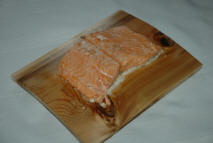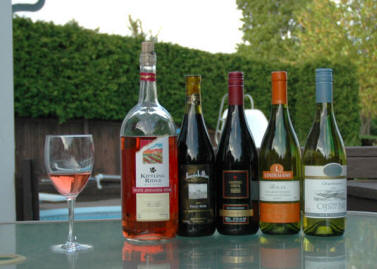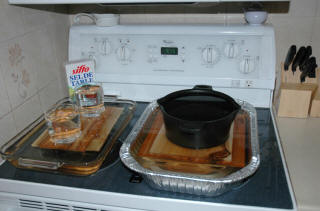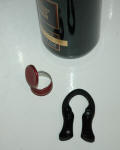The Great Cedar-Wanna-Be Salmon Bakeoff
 I'm a big fan of cedar plank salmon. Being a woodworker, I have come
across several types of 'cedar', so it got me to thinking -- what kind of cedar
makes the best cedar plank salmon. After a bit of research and many phone
calls I found I could only get two kinds of 'cedar' (that I know are safe) in
the area -- Western Red and Eastern White. (I should mention that I was
warned against using wood from Cedar hedges due to potential toxicity issues).
Before I go on, I should probably give a bit of a background on the wood, and
explain why I keep putting quotes around the word 'cedar'...
I'm a big fan of cedar plank salmon. Being a woodworker, I have come
across several types of 'cedar', so it got me to thinking -- what kind of cedar
makes the best cedar plank salmon. After a bit of research and many phone
calls I found I could only get two kinds of 'cedar' (that I know are safe) in
the area -- Western Red and Eastern White. (I should mention that I was
warned against using wood from Cedar hedges due to potential toxicity issues).
Before I go on, I should probably give a bit of a background on the wood, and
explain why I keep putting quotes around the word 'cedar'...
About Cedar-Wanna-Be's
There are a lot of types of wood which are called Cedar. Take for
example Cedar Hedges and Cedar Decking. If you've ever looked at a mature
cedar hedge, it doesn't take much to realize that this is not the same type of
Cedar used for decking. A mature cedar hedge has a trunk width of three to
four inches -- not enough to constitute a single plank for a deck or a fence.
If you've ever built a deck (and happen to be in North America), you have
probably heard of both Western Red Cedar and Eastern White Cedar. You have
probably figured out by now, given the title of the web page, that not all of
these are actually cedar. In fact, none of them are.
| Eastern White Cedar (also called Northern White Cedar) |
Thuja occidentalis -- Eastern White Cedar
is actually a member of the Cypress family. Apparently it was used
to cure Scurvy back in the day.
|
| Western Red Cedar |
Thuja plicata -- Western Red Cedar is also
a member of the Cypress family. It is sometimes called
arbor-vitae, Latin for "tree of life." This tree was very
important to the native Americans, who made canoes, rope, arrows, and
many other things from the tree. |
| Cedar Hedges |
Most Cedar Hedges are actually from the Juniper family
of trees. |
About Real Cedar
Real Cedar is of the species Cedrus. They grow in the
Himalaya and Mediterranean regions. Needless to say, I couldn't get any on
short notice, and thus real Cedar is exempt from my Cedar-Wanna-Be
bakeoff...(Apparently, the name Cedrus has been misapplied to may species of
trees. It tends to be applied to woods with a specific fragrance).
To find out more about real cedar, follow this
link
The History of Cedar Plank Salmon
Cedar Plank Salmon was first made by Native Americans. They tacked the
fish onto planks of cedar, and held the planks close to the fire. Now, if
you didn't skip over the previous section, you might be thinking 'wait a
second... Cedar grows in the Himalayas... so how could the Indians make
cedar baked salmon?' . And you would be correct -- the Native
Americans invented Cedar-Wanna-Be planked salmon, not cedar plank salmon.
The Native Americans used Western Red Cedar (again, a type of
cypress, not cedar). As a result, most cedar plank salmon calls for
Western Red Cedar. I'm not sure why Eastern White is never adopted --
maybe we'll find out at the bakeoff.
The Bakeoff
The plan was to grill salmon on as many kinds of cedar planks as possible,
and decide which varieties produced the best result. As it turns out, this
was a bit more difficult task than I anticipated. I happened to have some
untreated Western Red Cedar at home. White Cedar was a bit more of a
problem. The only suppliers of White Cedar that I could find in the Ottawa
Area were bulk sellers -- you had to place a large order to get any. I
only was anticipating 10-20 people, so placing a bulk order was not a good idea.
Fortunately, I knew someone who had just ordered a bunch of white cedar for a
shed he was building. He was kind enough to cut me some planks (he even
planed them down to 1/2 inch for me!)
Another friend offered to give me some wood from a cedar hedge he had cut
down. Apparently he had some longs that were three inches around.
However, I was warned that some woods might have toxins in them that could be
harmful to people, and I couldn't confirm whether Juniper was one of these
woods, so I decided not to use it.
I called around for other varieties of Cedar, even real cedar, but not even
the specialty wood shops carried any. I also tried to get Alder and
Mesquite, two other popular cooking woods, but again, no lumber yard carried
them, and it was to short notice to order them online. I happen to have
some Cherry at home, which can also be used for cooking, but it's pretty
expensive, so that was out as well.
What that left me with was planks of Western Red and Eastern White.
The Recipes
I looked online and found many recipes for Cedar Plank Salmon, but I also
found more than one site that suggested that salmon should be served as plain as
possible. This made a lot of sense, especially for a bakeoff. Some
of the best non-planked salmon I have made was done with nothing but some oil
and soy-sauce, and a slab of salmon. So this is the plan -- I will used
oil, soy-sauce, and a touch of pepper. The fish will be served with a side of dill mixed with sour cream.
A recipe with instructions can be found
here. I would recommend
avoiding any recipes that do not call for skinning the fish (see
below)
The Wine
 Consulting some of my Wine-Expert colleagues, I got some suggested wines for
the bakeoff. The suggested types of wine were Pinot Noir, and Chardonnay.
Though I saw a Sauvinough Blanc suggested on a website, my friends suggested
strongly against it, saying it would not keep up to the flavor of the salmon.
Consulting some of my Wine-Expert colleagues, I got some suggested wines for
the bakeoff. The suggested types of wine were Pinot Noir, and Chardonnay.
Though I saw a Sauvinough Blanc suggested on a website, my friends suggested
strongly against it, saying it would not keep up to the flavor of the salmon.
So the wines I got:
Oyster Bay Chardonnay (vintage): This is a New-Zealand vintage
wine. This was very highly recommended by my boss who is a big wine
connoisseur. The word 'vintage' means that it was an exceptional
year for the winery.
Batch 65 Chardonnay: Recommended by both my brother, and by the
guy at the wine store, this Australian wine is apparently always on back order.
Cooper Creek Pinot Noir: Another vintage wine, highly
recommended.
Inniskillin Pinot Noir: I needed another Pinot Noir, and this was
the first I came across.
Kettling Ridge White Zinphadel: (sigh...) my wife made me get it.
Preparation
Thursday Night
It's Thursday night, and I have to soak the planks. Unfortunately, the
planks don't fit into my pots. I have one glass serving plate that's big
enough to soak two pieces, but with 11 expected guests I'm going to need a bit
more. Off to Zellers to pick up something up...
 Ok, the aluminum foil baking trays seem to be very good for this. For
$4.00, I got a basting pan big enough to put in most of my boards. I
figure $4.00 compared to the cost of the wine and the salmon is a drop in the
bucket. I put the wood in the two pans. I added some thin slivers
between the boards, to ensure that all areas of the boards were exposed to the
water. I then weighed down the boards -- one I weighed down with a couple
of full glasses of water, the other with a pot full of water. I've heard
it suggested that you use a brick, but this is much easier. In my glass
container, I put a liberal amount of salt in the water. This was suggested
in one web site, so I thought I would try it to see if it made a difference.
Ok, the aluminum foil baking trays seem to be very good for this. For
$4.00, I got a basting pan big enough to put in most of my boards. I
figure $4.00 compared to the cost of the wine and the salmon is a drop in the
bucket. I put the wood in the two pans. I added some thin slivers
between the boards, to ensure that all areas of the boards were exposed to the
water. I then weighed down the boards -- one I weighed down with a couple
of full glasses of water, the other with a pot full of water. I've heard
it suggested that you use a brick, but this is much easier. In my glass
container, I put a liberal amount of salt in the water. This was suggested
in one web site, so I thought I would try it to see if it made a difference.
With that all done, it's time to clean the house. The wife already
vacuumed the pool, and did some outdoor stuff, so I don't have to worry about
the outside. So all I have to do tomorrow before the guests arrive
is to pick up the fish, and prepare it.
Friday
Everything is ready. My wife has picked up some salads, and I have
picked up the fish. I have skinned the fish, and all is ready to go.
Unfortunately the weather is not cooperating. It is overcast with a light
drizzle. So it will be an indoor party. There are a few last minute
cancellations which brings our number down to nine. I decide to freeze one
of the fish fillets.
 I
set the wine out on the table, and decide to uncork a few bottles. I have
one of those fancy corkscrews, which comes with a cutter to cut the foil around
the cork. I go to use it on the Cooper Creek Pinot Noir -- I cut the
'foil', and peel it back only to find no cork... A closer inspection shows
me that this was in fact a twist on cap, not a cork! Oops...
Luckily, we drank the whole bottle so it wasn't an issue.
I
set the wine out on the table, and decide to uncork a few bottles. I have
one of those fancy corkscrews, which comes with a cutter to cut the foil around
the cork. I go to use it on the Cooper Creek Pinot Noir -- I cut the
'foil', and peel it back only to find no cork... A closer inspection shows
me that this was in fact a twist on cap, not a cork! Oops...
Luckily, we drank the whole bottle so it wasn't an issue.
The guests arrive and I start by putting a plank of red Cedar in the
Barbeque, and a plank of white cedar in the oven. I brush each with a thin
layer of oil. I then add the salmon, and let them bake for about twenty
minutes. Twenty minutes pass by, and I take them out. I should note
that steam was still coming out of both boards -- neither had completely dried
before serving. After tasting them, it appeared as though neither soaked
the cedar flavor as much as I'd like. So for the next batch, I do not
brush oil onto the plank before cooking. I also reverse it such that the
red cedar plank is now in the oven and the white is on the Barbeque.
The second batch soaked in much more flavor from the boards, so not brushing the
boards with oil seemed like a good idea.
The Results
The results were mixed. Most people preferred the red-cedar salmon ( 6
to 3 ), but everyone enjoyed both. Almost everyone agreed that not
brushing the planks with oil seemed to make the fish absorb more flavor.
Also, most people preferred the fish done in the Barbeque over the one done in
the oven, but there were two exceptions, who felt strongly the other way.
The wine went quite well with the fish, and we all had a good time.
| 1 wanna-be cedar
plank (Wester Red Cedar, or Eastern White for something different)
Make sure it is not treated Cedar! |
| 1 Fillet of Salmon |
| Some Oil, and Soy
Sauce |
Soak the plank of cedar in water overnight. Ensure that it is
completely submerged. Remove the skin from the salmon. Preheat
barbeque. When Barbeque is ready, place cedar plank on barbeque, and let
it heat up for a few minutes. Place the salmon directly on the cedar
plank, with what was the skin side down. Rub the top with oil and soy
sauce, and let cook for about twenty minutes
Don't overcook the salmon. The salmon is done when it is opaque and
flaky. If the center is still a little raw, then this is a good time to
remove it from the flame. The center will finish cooking itself off of the
flame.
Many cedar-plank salmon recipes call for placing the salmon skin side down on
the plank -- this does not make sense as the skin of a fish in impermeable, and
thus it would prevent the cedar flavor from soaking into the fish.
To skin a salmon fillet, cut the meat of the fillet (but not the skin) about
an inch from the tail. Use a sharp knife to separate the skin from the
meat for a few inches after the cut. Poke a hole in the skin with the
knife for a finger grip (The skin can get quite slippery). With one hand,
grab the meat. With the other hand, hook your finger through the
hole in the skin, and simply pull the two apart.
 I'm a big fan of cedar plank salmon. Being a woodworker, I have come
across several types of 'cedar', so it got me to thinking -- what kind of cedar
makes the best cedar plank salmon. After a bit of research and many phone
calls I found I could only get two kinds of 'cedar' (that I know are safe) in
the area -- Western Red and Eastern White. (I should mention that I was
warned against using wood from Cedar hedges due to potential toxicity issues).
Before I go on, I should probably give a bit of a background on the wood, and
explain why I keep putting quotes around the word 'cedar'...
I'm a big fan of cedar plank salmon. Being a woodworker, I have come
across several types of 'cedar', so it got me to thinking -- what kind of cedar
makes the best cedar plank salmon. After a bit of research and many phone
calls I found I could only get two kinds of 'cedar' (that I know are safe) in
the area -- Western Red and Eastern White. (I should mention that I was
warned against using wood from Cedar hedges due to potential toxicity issues).
Before I go on, I should probably give a bit of a background on the wood, and
explain why I keep putting quotes around the word 'cedar'... Consulting some of my Wine-Expert colleagues, I got some suggested wines for
the bakeoff. The suggested types of wine were Pinot Noir, and Chardonnay.
Though I saw a Sauvinough Blanc suggested on a website, my friends suggested
strongly against it, saying it would not keep up to the flavor of the salmon.
Consulting some of my Wine-Expert colleagues, I got some suggested wines for
the bakeoff. The suggested types of wine were Pinot Noir, and Chardonnay.
Though I saw a Sauvinough Blanc suggested on a website, my friends suggested
strongly against it, saying it would not keep up to the flavor of the salmon. Ok, the aluminum foil baking trays seem to be very good for this. For
$4.00, I got a basting pan big enough to put in most of my boards. I
figure $4.00 compared to the cost of the wine and the salmon is a drop in the
bucket. I put the wood in the two pans. I added some thin slivers
between the boards, to ensure that all areas of the boards were exposed to the
water. I then weighed down the boards -- one I weighed down with a couple
of full glasses of water, the other with a pot full of water. I've heard
it suggested that you use a brick, but this is much easier. In my glass
container, I put a liberal amount of salt in the water. This was suggested
in one web site, so I thought I would try it to see if it made a difference.
Ok, the aluminum foil baking trays seem to be very good for this. For
$4.00, I got a basting pan big enough to put in most of my boards. I
figure $4.00 compared to the cost of the wine and the salmon is a drop in the
bucket. I put the wood in the two pans. I added some thin slivers
between the boards, to ensure that all areas of the boards were exposed to the
water. I then weighed down the boards -- one I weighed down with a couple
of full glasses of water, the other with a pot full of water. I've heard
it suggested that you use a brick, but this is much easier. In my glass
container, I put a liberal amount of salt in the water. This was suggested
in one web site, so I thought I would try it to see if it made a difference. I
set the wine out on the table, and decide to uncork a few bottles. I have
one of those fancy corkscrews, which comes with a cutter to cut the foil around
the cork. I go to use it on the Cooper Creek Pinot Noir -- I cut the
'foil', and peel it back only to find no cork... A closer inspection shows
me that this was in fact a twist on cap, not a cork! Oops...
Luckily, we drank the whole bottle so it wasn't an issue.
I
set the wine out on the table, and decide to uncork a few bottles. I have
one of those fancy corkscrews, which comes with a cutter to cut the foil around
the cork. I go to use it on the Cooper Creek Pinot Noir -- I cut the
'foil', and peel it back only to find no cork... A closer inspection shows
me that this was in fact a twist on cap, not a cork! Oops...
Luckily, we drank the whole bottle so it wasn't an issue.